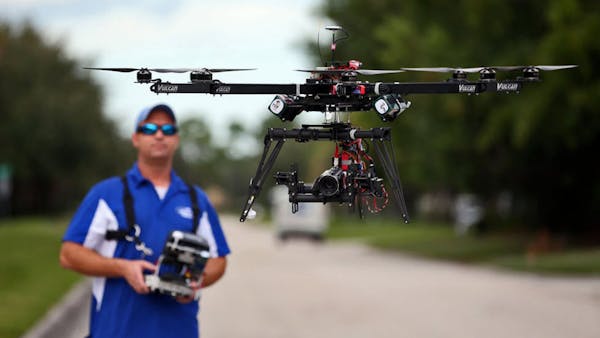Minnesota is hoping the drones that will soon be circling the skies over North Dakota will deliver an economic boost to this state, as well.
North Dakota beat Minnesota this week in the race to be named one of the Federal Aviation Administration's first six test sites of new commercial uses for unmanned aircraft systems. Beyond weapons or surveillance, researchers are hoping to put this technology to work in fields ranging from firefighting and search and rescue to farming.
In Thief River Falls, Minn., Northland Community and Technical College partnered with both Minnesota and North Dakota on their proposals to the FAA.
The school trains technicians to maintain these unmanned craft and now offers a degree in imagery analysis that teaches students to interpret the data the drones send back.
These skills are in such high demand that the program has a 100 percent placement rate, along with a substantial waiting list.
The program was designed with an eye for civilian uses for the technology, not military, said Curtis Zoller, the college's associate dean of aerospace programs.
"The students that complete the program are all but guaranteed a job. That doesn't even apply to the growth we're expecting because of the unmanned market," Zoller said. "Well after all of our students are placed, we still receive phone calls from multiple different industry sectors. Lockheed Martin, Northrop Grumman, Boeing, you name it … They all basically told us flat-out that no matter how many technicians we train, we won't meet their need."
Even before North Dakota was named an FAA test site, Zoller said, a study by the Minnesota State Colleges and Universities System estimated that Minnesota will see at least 1,700 new jobs for certified Airframe and Powerplant maintenance technicians; his college prepares students to take the FAA's A&P certification test. An unknown number of new jobs could come from the new unmanned aircraft technology.
Zoller pictures a future where farmers will use unmanned aircraft to spray their fields, where emergency rescue officials can survey storm damage or track chemical spills remotely.
Already, he said, the technology can identify the light of a cigarette from 5 miles away, which offers great promise for search and rescue workers trying to locate a lost hunter or a hiker in the cold northern Minnesota woods.
Economics vs. privacy
Before drone technology becomes commercially available, though, some Minnesota legislators would like to have a discussion of how to balance the economic benefits against privacy concerns.
State Sen. Sean Nienow, R-Cambridge, worries about possible abuses — whether by the deliberate malice of stalkers and vengeful exes or by a real estate agent who shoots an aerial view of a new property and ends up capturing images of the teenage girl sunbathing next door.
"We just don't have our arms around what the proper use of this technology is going to be," said Nienow, who offered a bill in the last session of the Legislature that would have prohibited law enforcement from using drones for routine surveillance or to gather evidence against citizens without a warrant. "We don't want to stifle jobs and business unnecessarily, but yet also balance individual privacy rights."
In April, the Hennepin County community of St. Bonifacius became one of the first towns in Minnesota to pass an ordinance restricting the use of aerial drones over its airspace.
Minnesota misses first round
Despite these qualms, Minnesota was one of 24 states that submitted proposals to become an FAA commercial drone test site. The first six research sites were awarded on Monday to Alaska, Nevada, New York, North Dakota, Texas and Virginia.
The federal government does not currently allow commercial use of drones, but it is working to develop operational guidelines, possibly by late 2015.
Within five years, there could be some 7,500 commercial drones aloft, the FAA predicts. Companies such as Amazon and UPS are toying with new uses for the technology — like drone package deliveries to your door.
All those new drones will need people to build, pilot and maintain them, and then interpret the data they send back.
An industry-commissioned study has predicted that more than 70,000 jobs would develop in the first three years after Congress loosens drone restrictions on U.S. skies. The same study projects an average salary range for a drone pilot of $85,000 to $115,000.
The Associated Press contributed to this report. Jennifer Brooks • 651-925-5049
In heated western Minn. GOP congressional primary, outsiders challenging incumbent

Minnesota Sports Hall of Fame: A class-by-class list of all members

This retired journalist changed professional wrestling from Mankato

